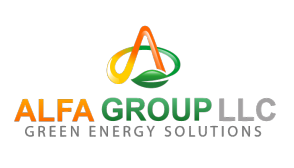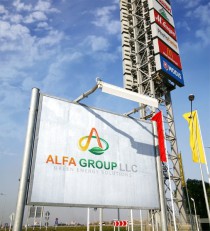PLASMA GASIFICATION PROCESS
DESCRIPTION OVERVIEW
The ALFA ENERGY SYSTEM™ initiates with the thermal transformation of waste to generate a clean combustible gas, henceforth referred to as "Fuel Gas." This Fuel Gas is employed to produce electricity through a combined cycle gas/steam turbine. Alternatively, it can be used to produce ethanol (denatured ethyl alcohol), a fuel that can be either blended with gasoline or burned as a neat fuel in an engine. The process also generates heat, which is used to produce electricity, superheat steam, heat boiler feedwater, and distill.
ZERO WASTE PHILOSOPHY
The process operates based on a ZERO WASTE philosophy, defined as:
1. The recycling of all materials back into nature or the marketplace in a manner that safeguards human health and the environment.
2. The conversion rate of any carbon-based material exceeds 99%. Non-carbon-based materials are transformed into vitrified glass, with molten metals separated from the glass. NON-CARBON BASED
FEEDSTOCK MATERIALS ARE CONVERTED INTO SALABLE PRODUCTS WITH NOTHING LEFT OVER. THE NEED FOR A LANDFILL IS VIRTUALLY ELIMINATED WITH THIS PROCESS!
3. The produced Fuel Gas is considerably cleaner than conventional gasification processes and contains only traces of some elemental contaminants like particulates, chlorine, sulfur, and metals
(quantities vary depending on the feedstock). Tars, furans, and dioxins are absent. Depending on the waste input, trace amounts of other elements may be present. Most of the particulate matter is
recirculated into the process, becoming part of the vitrified glass. Chlorine is scrubbed out, resulting in dilute hydrochloric acid (HCL), and sulfur is removed in a wet scrubber, producing sodium
bisulfite.
4. The dilute HCL, containing some particulate matter and metals, undergoes further removal. The particulates and metals removed at this stage amount to a fraction of 1% of the original
feedstock.
5. The dilute HCL can be concentrated to create a 20% salable HCL product. The water removed in either process is reused within the plant for makeup water. The only water discharge consists of
cooling tower and boiler blowdown.
6. The only air discharge originates from the turbine, which complies with EPA standards.
7. Heat generated by the process serves internal purposes, including electricity generation, ethanol distillation, and HCL distillation.
GUARANTEED TECHNOLOGY
The patented Thermal Transformation process technology has been successfully applied to various materials, including Municipal Solid Waste (MSW). The developer of the process is a reputable and well-established company.
The process is designed using GUARANTEED TECHNOLOGIES!
PROCESS FLOW DESCRIPTION
The ALFA Energy System™ process for converting Municipal Solid Waste (MSW) and other waste materials into energy and usable by-products can be divided into four subsystems: material handling, thermal transformation or plasma gasification, gas clean-up, and steam and energy production. A flow diagram is provided at the end of this section.
MATERIAL HANDLING
Incoming waste is weighed and deposited on the tipping floor from the trucks currently in use for collecting and transferring MSW. No extensive sorting or handling is required. The only necessary separation pertains to large oversized pieces that won't fit into the shredder, heavy metal items like engines that may slow down the shredder, or items needing special pre-processing, such as refrigerators, freezers, and AC units requiring the removal of freon. Hazardous waste and medical waste are managed separately and are not mixed with regular waste.
The system is designed for efficient waste processing. During delivery hours, waste arrives faster than it can be gasified. Some waste is stored for processing at night, on weekends, and holidays. Oversized material is shredded and then conveyed to storage.
The waste undergoes complete cycling every 3-4 days. In case of unscheduled shutdowns, the waste from the municipality goes into the storage area, designed to handle normal surges, and continues to accept waste.
THERMAL TRANSFORMATION
Waste is injected into the upper part of the thermal transformer (also known as the plasma gasifier or reactor) and accumulates within the reactor body. Plasma torches at the reactor's bottom generate a flame with temperatures ranging between 5000-8000º F.
Organic material doesn't burn due to insufficient oxygen. Instead, it transforms into a gas primarily composed of carbon monoxide (CO), hydrogen (H2), and nitrogen (N). This gas is highly energy-rich and can be utilized in various ways.
The hot gas rises through the waste in the reactor, initiating the gasification process on the piled material. By the time waste reaches the reactor's bottom, the high-temperature, oxygen-deprived environment has completely transformed all organic compounds into gas.
The gas exiting the reactor's top primarily consists of carbon monoxide, hydrogen, water, and nitrogen, with small amounts of chlorine, hydrogen sulfide, particulates, carbon dioxide, and low-boiling-point metals, depending on the feedstock. Due to the low oxygen atmosphere and high temperature, toxic compounds like furans, dioxins, NOx, or sulfur dioxide cannot form in the reactor.
As the gas exits the reactor, it first enters a proprietary gas reformer and then passes through a series of high-temperature heat exchangers, reducing sensible heat to around 270º F. This heat is used to generate high-pressure steam, which powers a steam turbine to produce electricity.
The high temperatures from the plasma torches liquefy all inorganic materials, such as metals, soil, glass, silica, etc. Everything except the metals becomes vitrified or molten glass. The metal and glass flow out of the reactor at approximately 3000º F and are quenched in a water bath. The glass forms obsidian-like fragments, and the metals are separated from the glass.
No waste remains at the end of the thermal transformation. All waste is either recycled into metal, glass, or converted into fuel gas.
GAS CLEANUP
After leaving the heat exchanger, approximately 85% of particulates are removed in a cyclone. A smaller percentage of metals is also removed with the particulates. Both particulates and metals are injected into the molten glass. The glass's components are encapsulated within the glass matrix and cannot leach out. The vitrified glass material passes EPA leachability tests.
The gas then proceeds through a scrubber where hydrochloric acid (HCL) is scrubbed out, forming dilute HCL water. This liquid undergoes further treatment, passing through a series of nano filter membranes to remove particulates and metals. The removed materials can be sold to a metal refiner or sent to a landfill. This minor amount of material is the only potential waste that might end up in a landfill, representing less than a fraction of 1 percent of the waste feedstock. The clean HCL water is concentrated to 15-20% for commercial sale.
The water within the gas is condensed and used to provide clean makeup water for the rest of the plant.
Hydrogen sulfide (H2S) in the gas is scrubbed out to produce fertilizer-grade sulfur through a biological process or can be converted into sodium bisulfite. The gas then proceeds to a gas compressor and, subsequently, to the gas turbine.



